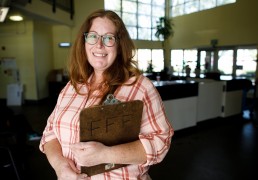As COTS’ CEO, each month I take a moment to consider what I want our community to know about our organization and our progress in serving Sonoma County’s homeless. I look forward to sharing these thoughts with you in this Virtual Cup of Coffee – my monthly communique about the business and mission moments of COTS (Committee On The Shelterless).
My best,
Chuck

Homelessness and Social Innovation
Homelessness is an extreme form of poverty and human deprivation. It’s now the most visible and major problem that many cities face, especially in California. There is a growing gap between the scale of the problem and the solutions we offer. Just visit San Francisco, Los Angeles, or even some of our cities in Sonoma County.
Social Innovation or SI is about applying solutions to social or environmental problems to address unmet needs and improve people’s lives. It’s not a new concept and doesn’t require inventing new products or services. It can apply an existing product or service in a new context. SI however must address the problem better than the existing alternatives.
We can think of SI as a four-step process – identify a new or unmet social need; develop a new solution to the need; evaluate the effectiveness of the solution; and then if the SI is successful, scale up the innovation. The last step is called Social Entrepreneurship, where we apply business practices to scale up the innovation for greater positive impact.
The reason I talk about Social Innovation is that I’m encouraged by what I am seeing in Sonoma County from our homeless services partners and their willingness to innovate to address homelessness. For example, Tiny Homes are not new. They’ve been around since the 1970s. It’s just of late that cities started using Tiny Homes to address their growing homeless population exacerbated by the lack of affordable housing, cost of living, and the impact of COVID. Now, there are several Tiny Homes projects in Sonoma County and more on the way.
Our Continuum of Care team is talking about an Open HMIS (Homeless Management Information System) where we share client information between homeless providers in the County. As the unsheltered utilize the same shelters and providers, having an Open database system with updated client information prevents the client from retelling their story again and again and thus being retraumatized. It also makes for a more efficient process as the next provider can pick up the case management process from the last provider. It’s like a person’s medical record being available to all their medical providers. An open database system or software system is not a new concept – just think of Linux and their open-source process. We are just using the concept to provide better, more efficient services for those experiencing homelessness.
And we are also talking about a Centralized Housing Locator function staffed by housing professionals that know the rental market. Instead of homeless providers each hiring their own Housing Locator and competing to find housing for the unsheltered, a centralized process is cheaper and more efficient. It’s also a common business practice.
No too long ago, the thought of any of the above was unthinkable. But because of the growing gap between the scale of the problem and solutions, we need to work differently. One benefit of Social Innovation is that more collaboration and social relationships are being created. We’re trusting each other and communicating more. And we’re sharing our plans and our mistakes made so that the next person who tries a tiny homes village doesn’t make the same mistakes. We are making progress.
One more Social Innovation I’d like to implement in Sonoma County is an “Innovation Fund.” There are people, organizations, and start-ups with ideas, they just need seed funding to start. I can think of some in Santa Rosa (SAVS), Sonoma Valley (Homeless Action), and Petaluma. They are a scrappy bunch that are persistent, bold, daring, undeterred, and fiercely passionate about their ideas and mission. Doesn’t sound too different from some in Silicon Valley. So why not set aside funding every year to try new ideas. And so what if they fail. You just step back, reassess, try again, and perhaps fail again. Ultimately with the right support and guidance, some will hopefully succeed. The truth is that many start-up businesses fail. Social innovation or social entrepreneurships are no different. However, one thing is for sure – they all have the starting point of empathy and concern for the homeless and to treat them with dignity and respect. I think that is worth investing in.

Until next month,

Chuck Fernandez